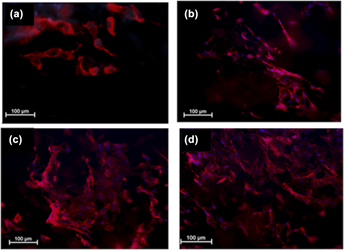Crossref Citations
This article has been cited by the following publications. This list is generated based on data provided by
Crossref.
Datta, Sudipto
Das, Ankita
Chowdhury, Amit Roy
and
Datta, Pallab
2019.
Bioink formulations to ameliorate bioprinting-induced loss of cellular viability.
Biointerphases,
Vol. 14,
Issue. 5,
Chircov, Cristina
and
Grumezescu, Alexandru Mihai
2019.
Materials for Biomedical Engineering.
p.
19.
Rastogi, Prasansha
and
Kandasubramanian, Balasubramanian
2019.
Review of alginate-based hydrogel bioprinting for application in tissue engineering.
Biofabrication,
Vol. 11,
Issue. 4,
p.
042001.
Smandri, Ali
Nordin, Abid
Hwei, Ng Min
Chin, Kok-Yong
Abd Aziz, Izhar
and
Fauzi, Mh Busra
2020.
Natural 3D-Printed Bioinks for Skin Regeneration and Wound Healing: A Systematic Review.
Polymers,
Vol. 12,
Issue. 8,
p.
1782.
Mancha Sánchez, Enrique
Gómez-Blanco, J. Carlos
López Nieto, Esther
Casado, Javier G.
Macías-García, Antonio
Díaz Díez, María A.
Carrasco-Amador, Juan Pablo
Torrejón Martín, Diego
Sánchez-Margallo, Francisco Miguel
and
Pagador, J. Blas
2020.
Hydrogels for Bioprinting: A Systematic Review of Hydrogels Synthesis, Bioprinting Parameters, and Bioprinted Structures Behavior.
Frontiers in Bioengineering and Biotechnology,
Vol. 8,
Issue. ,
Badhe, Ravindra V.
and
Nipate, Sonali S.
2020.
Advanced 3D-Printed Systems and Nanosystems for Drug Delivery and Tissue Engineering.
p.
109.
Karavasili, Christina
Tsongas, Konstantinos
Andreadis, Ioannis I.
Andriotis, Eleftherios G.
Papachristou, Eleni T.
Papi, Rigini M.
Tzetzis, Dimitrios
and
Fatouros, Dimitrios G.
2020.
Physico-mechanical and finite element analysis evaluation of 3D printable alginate-methylcellulose inks for wound healing applications.
Carbohydrate Polymers,
Vol. 247,
Issue. ,
p.
116666.
Xu, Jie
Zheng, Shuangshuang
Hu, Xueyan
Li, Liying
Li, Wenfang
Parungao, Roxanne
Wang, Yiwei
Nie, Yi
Liu, Tianqing
and
Song, Kedong
2020.
Advances in the Research of Bioinks Based on Natural Collagen, Polysaccharide and Their Derivatives for Skin 3D Bioprinting.
Polymers,
Vol. 12,
Issue. 6,
p.
1237.
Datta, Sudipto
Barua, Ranjit
and
Das, Jonali
2020.
Alginates - Recent Uses of This Natural Polymer.
Datta, Sudipto
Barua, Ranjit
and
Das, Jonali
2020.
Alginates - Recent Uses of This Natural Polymer.
Saygili, Ecem
Dogan-Gurbuz, Asli Aybike
Yesil-Celiktas, Ozlem
and
Draz, Mohamed S.
2020.
3D bioprinting: A powerful tool to leverage tissue engineering and microbial systems.
Bioprinting,
Vol. 18,
Issue. ,
p.
e00071.
Datta, Sudipto
Das, Ankita
Sasmal, Pranabesh
Bhutoria, Sumant
Roy Chowdhury, Amit
and
Datta, Pallab
2020.
Alginate-poly(amino acid) extrusion printed scaffolds for tissue engineering applications.
International Journal of Polymeric Materials and Polymeric Biomaterials,
Vol. 69,
Issue. 2,
p.
65.
Askari, Mohsen
Afzali Naniz, Moqaddaseh
Kouhi, Monireh
Saberi, Azadeh
Zolfagharian, Ali
and
Bodaghi, Mahdi
2021.
Recent progress in extrusion 3D bioprinting of hydrogel biomaterials for tissue regeneration: a comprehensive review with focus on advanced fabrication techniques.
Biomaterials Science,
Vol. 9,
Issue. 3,
p.
535.
Huang, Hanxiao
Ayariga, Joseph
Ning, Haibin
Nyairo, Elijah
and
Dean, Derrick
2021.
Freeze-printing of pectin/alginate scaffolds with high resolution, overhang structures and interconnected porous network.
Additive Manufacturing,
Vol. 46,
Issue. ,
p.
102120.
Nazarnezhad, Simin
Hooshmand, Sara
Baino, Francesco
and
Kargozar, Saeid
2021.
3D printable Gel-inks for Tissue Engineering.
p.
191.
Saha, Sayandeep
and
Datta, Pallab
2021.
3D printable Gel-inks for Tissue Engineering.
p.
27.
Ramesh, Srikanthan
Harrysson, Ola L.A.
Rao, Prahalada K.
Tamayol, Ali
Cormier, Denis R.
Zhang, Yunbo
and
Rivero, Iris V.
2021.
Extrusion bioprinting: Recent progress, challenges, and future opportunities.
Bioprinting,
Vol. 21,
Issue. ,
p.
e00116.
Masri, Syafira
and
Fauzi, Mh Busra
2021.
Current Insight of Printability Quality Improvement Strategies in Natural-Based Bioinks for Skin Regeneration and Wound Healing.
Polymers,
Vol. 13,
Issue. 7,
p.
1011.
Bonsignore, Gregorio
Patrone, Mauro
Martinotti, Simona
and
Ranzato, Elia
2021.
“Green” Biomaterials: The Promising Role of Honey.
Journal of Functional Biomaterials,
Vol. 12,
Issue. 4,
p.
72.
Gao, Qiqi
Kim, Byoung-Soo
and
Gao, Ge
2021.
Advanced Strategies for 3D Bioprinting of Tissue and Organ Analogs Using Alginate Hydrogel Bioinks.
Marine Drugs,
Vol. 19,
Issue. 12,
p.
708.





